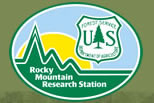 Rocky Mountain Research Station
Rocky Mountain Research Station
|
|
 Science Program Areas
Science Program Areas
|
|
 Hot Topics
Hot Topics
|
|
 Cross-Program Projects
Cross-Program Projects
|
|
 Research Laboratories
Research Laboratories
|
|
 Tools, Applications and Data
Tools, Applications and Data
|
|
 People
People
|
|
 About RMRS
About RMRS
|
|
 Contact RMRS
Contact RMRS
|
|
 Search
Search
|
|
 2009 Congressional Briefing
2009 Congressional Briefing
|
 RMRS Publications
RMRS Publications
|
 Experimental Forests
Experimental Forests
|
 Partnerships
Partnerships
|
 US Forest Service Links
US Forest Service Links
|
 RMRS Archives
RMRS Archives
|
|
|


|
|
Rocky Mountain Research StationWelcome to the Rocky Mountain Research StationWelcome from Sam Foster, RMRS Station Director
Welcome to the US Forest Service, Rocky Mountain Research Station's home page. I am very proud of our employees and the work that they do. We are here to serve the American public, and through this website we have provided a host of information that we think will help you understand our natural environment. Our research results help decision makers develop informed choices about the conservation of natural resources. Please explore our website and learn what we have to offer. You will find links to websites for our research programs. The Station's published research is available free of charge through this website.
our welcome video.
Science NowThe Race Against White Pine Blister Rust Those gnarly, old, stately trees that reside on mountaintops throughout the Rocky Mountains have withstood
harsh weather, hurricane-like winds, and other stresses for hundreds, maybe thousands, of years.
A new alarming reality is that these resilient five-needle pine forests are not beyond the reach of
human-caused stresses that threaten their survival and sustainability.
Those gnarly, old, stately trees that reside on mountaintops throughout the Rocky Mountains have withstood
harsh weather, hurricane-like winds, and other stresses for hundreds, maybe thousands, of years.
A new alarming reality is that these resilient five-needle pine forests are not beyond the reach of
human-caused stresses that threaten their survival and sustainability.
What’s Happening to the Western Aspen? Those who live in the western mountain areas look forward to the spectacular fall coloration of aspen.
But some aspen stands are dying here in the West, with many stands being replaced by conifers, prompting
researchers to examine the reasons and look for the best restoration methods.
Those who live in the western mountain areas look forward to the spectacular fall coloration of aspen.
But some aspen stands are dying here in the West, with many stands being replaced by conifers, prompting
researchers to examine the reasons and look for the best restoration methods.
Bark Beetles: Not All Bad?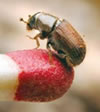 Bark beetles have taken a toll on the coniferous forests of the west, and it’s not a pretty sight. The beetle outbreaks have left behind acres and acres of dead trees with rust-colored needles. But the outbreaks are not all bad. Tree die-offs affect the scenery and introduce management challenges in high-value areas such as ski areas, campgrounds, and sites managed for forest products. But the bark beetles have a place in ecological processes such as nutrient cycling, providing food and habitat for wildlife.
Bark beetles have taken a toll on the coniferous forests of the west, and it’s not a pretty sight. The beetle outbreaks have left behind acres and acres of dead trees with rust-colored needles. But the outbreaks are not all bad. Tree die-offs affect the scenery and introduce management challenges in high-value areas such as ski areas, campgrounds, and sites managed for forest products. But the bark beetles have a place in ecological processes such as nutrient cycling, providing food and habitat for wildlife.
How Lynx Choose Dens Finding a suitable home is an important challenge facing Canada lynx, a species listed in 2000 as threatened under the Endangered Species Act. But the specific type of habitat the Canada lynx prefer hasn’t been well defined, which makes managing the ecosystems that affect the lynx difficult. A new study that tracked lynx habitat behavior from 1999 to 2006 helps answer some of the questions about lynx habitat.
Finding a suitable home is an important challenge facing Canada lynx, a species listed in 2000 as threatened under the Endangered Species Act. But the specific type of habitat the Canada lynx prefer hasn’t been well defined, which makes managing the ecosystems that affect the lynx difficult. A new study that tracked lynx habitat behavior from 1999 to 2006 helps answer some of the questions about lynx habitat.
Are Wildfires Good for Amphibians? Boreal toads like it hot. Although wildfires can threaten some sensitive species, a recent study finds that certain amphibians are resistant, and boreal toads might even benefit from wildfires.
Boreal toads like it hot. Although wildfires can threaten some sensitive species, a recent study finds that certain amphibians are resistant, and boreal toads might even benefit from wildfires.
Visit ScienceNow Archive for previous articles. What's New2008 Strategic Framework Update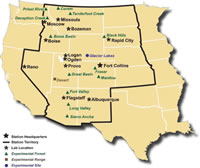
The
2008 Strategic Framework Update
has recently been published. This and the
Strategic Framework (2003)
will help guide the station over the next decade. It is the product
of a dialog with our stakeholders and employees to examine the
station’s capabilities, anticipate research issues, and describe our
future role.
Stream Temperature Modeling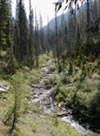
Stream Temperature Modeling,
a site developed by the Air, Water and Aquatics Science Program,
describes three different statistical procedures for predicting suitable fish habitat by modeling or inferring stream temperature. Statistical temperature models are well suited for broad-scale applications because they are less data intensive than mechanistic stream models, provide estimates of parameter precision, and can often be easily derived from existing databases.
2008 RMRS Research Accomplishments Report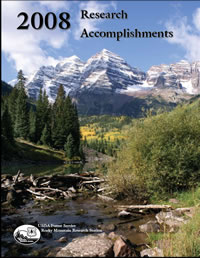
The 2008 RMRS Research Accomplishments report
highlights the station's activities in 2008, including long-term research at experimental forests and rangelands, conserving biological diversity in
research natural areas, conservation education, and science and resource management.
Middle Rio Grande Basin Research Report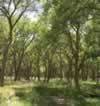
The 2008
Middle Rio Grande Basin Research Report
on the
understanding, conserving, and
restoring southwestern ecosystems
is available.
An ecosystem is rarely static. A natural system composed of plants, animals, and
microorganisms interacting with an area’s physical factors, an ecosystem is always
fluctuating and evolving. But sometimes, often at the hands of humans, ecosystems
change too much. Such is the case with many of the ecosystems of the Middle Rio
Grande Basin of New Mexico.
Treesearch citation.
Invasive Species Science Update Newsletter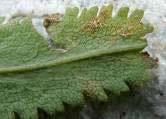
The Invasive Species Science Update newsletter publishes contributions concerning the ecology and management of invasive species. Articles in this second issue include fire effects on invasive species and biological control of invasive plants.
The newsletter will be published three times yearly.
Recent PublicationsVisit RMRS Publications for access to all station publications. Printed copies of all station publications can be ordered free of charge.For externally refereed publications, visit either |
|
Rocky Mountain Research Station
Last Modified: Tuesday, 5 May 2009 at 17:05:07 EDT (Version 1.0.5)



